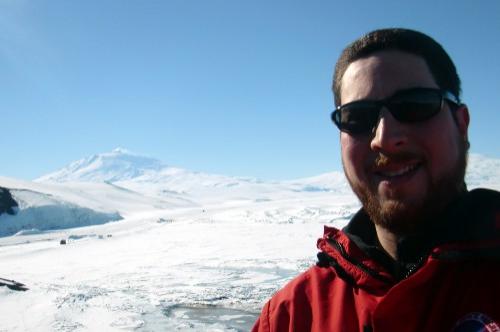Today we were blessed with an absolutely beautiful day. The sky was crystal clear with an intense blue, and the Sun was shining as brightly as it is possible from Antarctica. Temperature was near freezing, but with the Sun and the calm air the weather felt incredibly mild.
 Selfie photograph with Mt. Erebus in the background.
Selfie photograph with Mt. Erebus in the background.
I started my day bright and early with a visit to Crary Labs here in McMurdo. Crary Labs—itself one of the main buildings at the station—is where most of the science is done, and it features an impressive number of exhibits relating to Antarctica.
 Main entrace at Crary Lab (i.e., Albert P. Crary Science and Engineering Center) at McMurdo Station.
Main entrace at Crary Lab (i.e., Albert P. Crary Science and Engineering Center) at McMurdo Station.
My visit to Crary was to attend a PolarConnect event with Yamini Bala, a fellow PolarTREC teacher who is also staying at McMurdo. Yamini had just come back from the West Antarctic Ice Sheet (WAIS) Divide here in Antarctica, where she studied the microstructure of ice crystals together with other members of the "VeLveT Ice" team. She did an awesome job at explaining what the science and research at WAIS Divide were, which made for a unique learning experience. I also had the pleasure to meet her researcher, glaciologist Dr. Erin Pettit, as well as other members of the team. Yamini's PolarTREC journal is available from the following address: http://www.polartrec.com/expeditions/west-antarctic-ice-sheet-microstructures
 PolarConnect event with PolarTREC teacher Yamini Bala.
PolarConnect event with PolarTREC teacher Yamini Bala.
 Yamini Bala talking to the audience.
Yamini Bala talking to the audience.
Around 2:00 pm and taking advantage that the Sun had just passed the meridian and attained its maximum elevation of 32°, I went out and walked down the road in order to obtain a better view of Mt. Erebus. Along the way—an easy, 45-minute walk—I saw a number of South polar skuas (Stercorarius maccormicki) flying high above the road. These birds are a common sight along the Antarctic coast, as they feed on the abundant fish in the surrounding sea.
 South polar skuas (Stercorarius maccormicki) flying above the road.
South polar skuas (Stercorarius maccormicki) flying above the road.
The road climbs steadily and reaches a high point about two thirds of the way from the US McMurdo Station to New Zealand's Scott Base, and the panorama that spreads out from South to West is absolutely impressive. When the sky is clear as it was today, White Island can be seen very prominently (due south) just across the Ross Ice Shelf, with Black Island to the right. Mt. Discovery—an isolated volcano that is located about 70 kilometers to the southwest—and the Brown Peninsula are also easily seen further to the right.
 The Ross Ice Shelf with White Island in the background, as seen from the road.
The Ross Ice Shelf with White Island in the background, as seen from the road.
 Zoomed-in view of Mt. Discovery with the hills of Brown Peninsula.
Zoomed-in view of Mt. Discovery with the hills of Brown Peninsula.
As explained, I was wanting to get a full view of Mt. Erebus. The volcano—itself the most prominent natural feature of Ross Island—cannot be seen from McMurdo proper due to nearby hills blocking the view. Its summit is visible from the top of Observation Hill, but a better view is obtained from the eastern side of the Point Hut peninsula, just outside of Scott Base.
As I continued my walk the road came to a quick descent and I reached the outskirts of Scott Base. I looked north and was treated to an amazing view of Mt. Erebus. There was a plume of smoke above the volcano that, because of the permanent lava lake that sits inside the caldera, is a rather common occurrence. But for me it was absolutely noteworthy, as never before in my life I had seen smoke coming out from a volcano.
 Wide field view of Mt. Erebus and surroundings.
Wide field view of Mt. Erebus and surroundings.
 Zoomed-in view of Mt. Erebus with smoke arising from summit.
Zoomed-in view of Mt. Erebus with smoke arising from summit.
I was also able to get a magnificent view of Mt. Terror, another of Ross Island's volcanoes, although it is thought to be either dormant or extinct. Preliminary studies of rocks around Mt. Terror show no signs of volcanic activity within the last million years.
 Zoomed-in view of of Mt. Terror.
Zoomed-in view of of Mt. Terror.

Comments